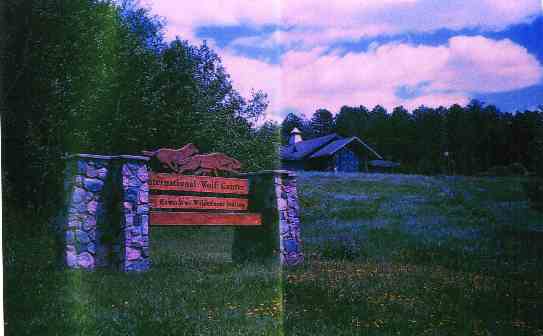
Outpost Attractions
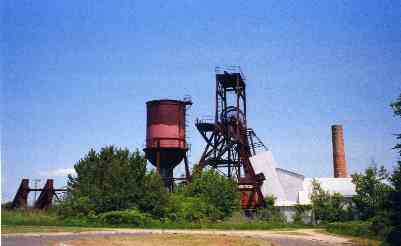
| Route 66 | Cities | Beaches |
 |
Outpost Attractions |
 |
Yes, of course, you're coming all this way to canoe the greatest water wilderness in the world. However, Ely offers much more. On a rainy day, or on your way into or out of the Boundary Waters, you really must visit these outstanding attractions. They focus on the animals of the region, the industrial and human history of the last two centuries, and the modern culture of a unique town isolated on the line between civilization and wilderness. For starters, you might consider taking in a movie. You can go to a movie back home. But no longer like this. Ely's State Theatre is a single screen small town movie house showing first run features in the same kind of facility seen everywhere in America back in the 1950s, before multiplex miniscreen shopping mall cinema complexes. On a Friday or Saturday night, you should arrive early because the place sells out. This is not a newly built or restored replica. It is the same theatre Ely has had for a century. The State is on the main street in downtown Ely. There is plenty of free parking nearby. Arrive early and walk up and down the street for a few blocks, noticing how there are no vacant storefronts. Unlike many small towns, this business district is thriving. We talk about various attractions in Ely, but the town itself is an attraction. For kids from cities, or from small towns economically depressed by outsourcing, Ely is a vision of what American towns once looked like and perhaps could look like again. |
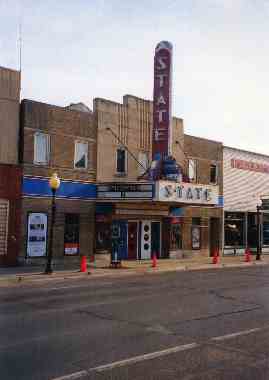 |
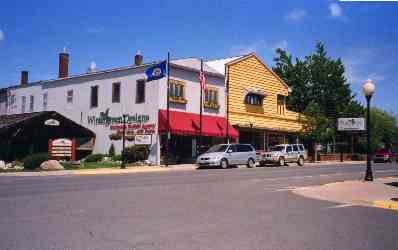 |
Heroes often show up in unexpected places. The last 10 years have seen over one billion jobs shipped abroad. In the textile and garment industries, 90% of all world manufacturing is now done in China. In the outdoor sports field 90% of all equipment and clothing is made overseas. We are told there is no way American plants can bring costs low enough to compete with low Asian wages and production expenses. American consumers do not care about quality or where something is made. They buy on price. The global economy means no company can survive paying high American wages and benefits. Somehow, Wintergreen Industries defies this. Right on the main street in Ely, they take raw fabric in the back door and create beautiful, warm, highly functional outdoor clothing which is then sold directly to the consumer at the front door. Those front doors are shown at left. Buying a Wintergreen garment is part of an Ely trip for many canoeists. See their website at wintergreennorthernwear.com |
| You can watch the worker create your garment, then buy it. The woman at right is crafting a jacket that we are going to buy for $100. These are light, medium and heavy weight parkas, jackets, anoraks, and other items. Wintergreen executives lead expeditions to some of the coldest places on Earth, where these garments are tested in very hostile conditions. They are guaranteed for the life of the purchaser and if you have any complaints or problems you can bring it back and they'll fix it. These are not bland garments, either. There is a strong Ojibwe flavor to Wintergreen designs. Bright and intricate decorative strips run along seams, cuffs and edges. The company mails out catalogues and you can mail order any items, but we love the idea of watching them make it. Quality outdoor equipment is expensive. The Asian knockoffs you can buy at KMart or other outlets are not guaranteed, are not as well made, are not as warm, do not have as many features, and do not look as good. So far enough consumers have been willing to pay the higher price for Wintergreen garments. | 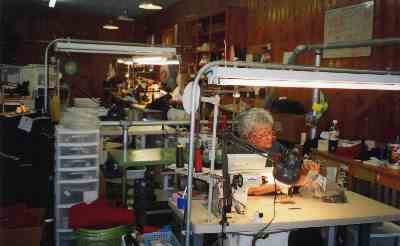 |
 |
Follow Main Street out to the East side of town and the
International Wolf Center, a mandatory stop. Do not come
to the Boundary Waters without visiting the Wolf Center. You will learn
about the history of wolves, the different species, their intelligence,
anatomy, lifestye, interactions with humans, and, most importantly, the
dynamics of pack behavior. At the Wolf Center a resident pack roams free
while trained guides explain to you their interactions. You can spend
as long as you want from comfortable observation points watching the wolves
go about their daily routine. There is a theatre showing various feature
length films on wolves on a two day rotating schedule. They cover everything
from wolves in Alaska to wolves in India to wolves in Africa. Displays
and presentations by various staff members could keep you busy for at
least one full day. The building includes a gift shop. The Wolf Center
also includes the Ranger Office where you can buy Boundary
Waters permits and maps and plan your trip with a ranger, and watch the
film on trip safety and proper procedures. |
| Adjacent to the Wolf Center is The Dorothy Moulter Museum, telling the story of the last permanent Boundary Waters resident. Dorothy came from Chicago to serve as a nurse at a resort on Knife Lake. When the owners died, they left it to her. But when the government created the Boundary Waters Wilderness, they ruled that cabins and resorts be dismantled. After negotiation, Dorothy was exempted and allowed to live out her life on Knife Lake. People could come and stay at her resort but she could not charge fees. Customers responded by making donations, which were legal. Because of the huge number of canoeing parties passing through, Dorothy began making her own root beer and selling it. After the wilderness designation, she could not charge for that either, but canoieists also made donations. A book was written and National Geographic documentary was filmed on her. When she died, her cabins were dismantled, brought to Ely, and used to create this museum. You will see a film, tour the cabins, and talk to guides who knew her well. | 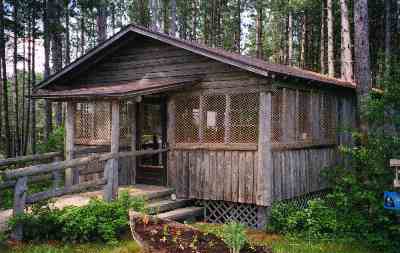 |
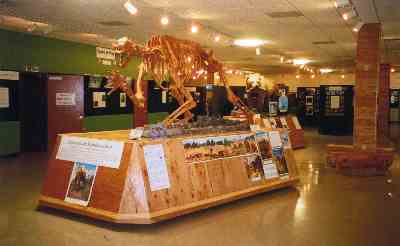 |
Across town, near the Burntside Lake turnoff, is the Bear Center. Open only a year, it is less well financed than its Wolf counterpart across town. The Wolf Center occupies a state of the art building while the Bear Center is in a concrete block and steel big box that looks like a Sam's Club. The Bear Center's displays look like they are done by advanced students, not museum professionals. The prehistoric skeleton at left is the highlight of the building. And the Bear Center only hosts two live bears, one a reclusive female named 'Honey" guests rarely see, the other a seriously obese male named "Teddy" who everyone in Ely thinks needs a diet. At this point the Bear Center is probably worth 60 to 90 minutes of your time. However, there is a lot of valuable information in the displays, and the photos are often outstanding. In 10 years this will probably be an outstanding center, and you can say you were there in its formative period. |
| You need to spend some time browsing the shops of Ely. There are lots of outdoor equipment dealers, art galleries, a bookstore (on the second floor above Pirogis), and even a Lionel model train store (Ely was a railroading center during its century as a logging and iron mining capitol and the old passenger station is just two blocks off Main Street). Brookings, shown here at right, is probably the best place in town to shop for a gift to take home to someone. Their two best items are beautiful fleece blankets embroidered right here with canoes, cabins, moose, wolves and loons; and locally handmade Christmas tree decorations with a Boundary Waters motif, such as canoes, dogsleds, fishing rods, tents, and paddles. The 80 year old who does the decorations comes in at 9 am every day, and the woman does the embroidery right across the street. | 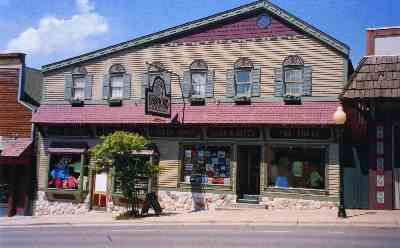 |
 |
At the top of the page at left is one of Ely's old iron mines, now idle. The one you should spend half a day in is Soudan Mine, which for a century was the largest underground iron mine in the world and is now open for tours. It is located in Tower, a village 25 miles West of Ely. The State of Minnesota operates Soudan as a historic site. You explore the visitor center, dry house, drill shop, crusher house, engine house, and boardwalk past one of the world's largest open pit mines, then enter the mine by boarding the original elevator ("the manlift"), a creaky contraption which vibrates its way 2471 feet deep into the earth, where you transfer to a mine train. The tour lasts about 90 minutes. The most spectacular part of your visit will be the Soudan Underground Laboratory, which occupies the deepest level of the mine and studies neutrinos, dark matter and cryogenics. One tour ticket costs $10 but group rates are available. |
| Fishing is an option anytime in the Ely area. The Boundary Waters are famous for fishing and half of the people here have come for that specific purpose. You can fish from docks, shorelines, canoes or on gateway lakes from motorboats. You are fishing for Walleye, Northern Pike, Lake Trout and Smallmouth Bass (shown at right). You can use live bait or artificial lures. Accurate and long casting is a skill to practice back home so you'll be good at it when you arrive in Ely. If you don't have the equipment or if no one in your group is an experienced fisher, consider hiring a guide. They have the equipment, bait and properly equipped boat. They will know exactly where the fish are biting on the day you are fishing and they can quickly move you from one area of the lake to another. We particularly like Jim Orcutt. 218-349-3658. Jim@JimTheFishGuy.com. He guides fishing clients on Shagawa, White Iron, Farm and Big Lake, and can be hired for Burntside, although he insists its fishing is declining. Orcutt offers a shore lunch option, in which he makes sure you catch the fish, then takes you to shore to cook and eat them. Jim is especially good at working with kids and families, or youth groups (he can call a few colleagues to share the load, since each fishing boat can only haul five. Or you could schedule different groups on consecutive days.). If you fish on your own, remember Minnesota requires that everyone fishing anywhere needs a state license, and it must be in their possession any time they're fishing or carrying fishing gear. www.dnr.state.minn.us. You can apply for the license by internet and mail the form in. We suggest a half day of guided fishing early on a first trip. Then, once you know what you're doing, you can rent equipment. Minnesota fishing is increasingly catch and release unless you're cooking it at shoreline, either on the grille, in camp or in the cabin. Walleye is the huge favorite among most Boundary Waters locals or visitors, although some prefer Trout. | 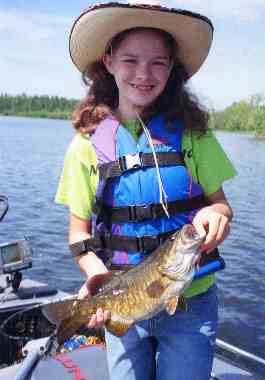 |
|
|||
|